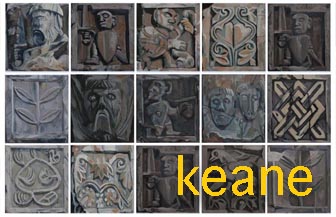On the bench outside Aristodemo’s bar, there once lay an old plastic fertiliser sack. At first glance, it didn’t seem important—just another leftover object—but it held more than just charcoal. It offered a glimpse into a way of life that was already fading.
The charcoal inside had come down from the mountains, made by one of the last families still using traditional methods. It was a craft that had sustained many local families for generations, though by then only a few of the old hands were still keeping it alive.
This particular sack hadn’t been sold for money. Instead, it had been exchanged for one of Aristodemo’s well-known sheep’s cheeses. Bartering was still common in those days—quiet, practical arrangements between people who trusted each other.
Even the way the sack was sealed told part of the story. Rather than rope or wire, three short sticks had been bent and pushed through the plastic to hold the top shut. It was a method that was both simple and effective, passed down through time. But it also had a second purpose.
When charcoal was sold by weight, the burners had developed a clever system. After filling and weighing a sack, they would scrape the bark from one of the sealing sticks and write the weight directly onto the clean white wood beneath. That stick served as the official record.
Then, a little charcoal might quietly be removed from the sack. A second stick would be marked with the new, lighter weight. When it came time to show the weight, the burner would present the stick showing the higher figure. If anyone raised a question, a quick shift of the hand would reveal the stick with the lower number—appearing transparent while keeping the difference.
It was a small trick, one of many that helped people stretch a living from difficult work. And that old sack, sitting outside the bar, quietly held the memory of it all.
From the barganews archives 24th November 2001
Un Vecchio Sacco Fuori dal Bar
Sulla panchina fuori dal bar di Aristodemo giaceva un vecchio sacco di plastica per fertilizzante. A prima vista non sembrava nulla di importante—solo un oggetto dimenticato—ma conteneva molto più del semplice carbone. Offriva uno sguardo su uno stile di vita che stava già scomparendo.
Il carbone all’interno era stato portato giù dalla montagna, prodotto da una delle ultime famiglie che ancora utilizzavano i metodi tradizionali. Era un mestiere che aveva sostenuto molte famiglie locali per generazioni, anche se a quel punto solo pochi vecchi artigiani lo mantenevano in vita.
Quel sacco in particolare non era stato venduto per denaro. Era stato scambiato con uno dei famosi pecorini di Aristodemo. All’epoca, il baratto era ancora comune—accordi silenziosi e pratici tra persone che si fidavano l’una dell’altra.
Anche il modo in cui il sacco era stato chiuso raccontava una parte della storia. Invece di corda o filo, tre bastoncini corti erano stati piegati e infilati nella plastica per sigillare l’apertura. Era un metodo semplice ed efficace, tramandato nel tempo. Ma aveva anche un secondo scopo.
Quando il carbone veniva venduto a peso, i carbonai avevano sviluppato un sistema ingegnoso. Dopo aver riempito e pesato un sacco, raschiavano via la corteccia da uno dei bastoncini usati per chiuderlo e scrivevano il peso direttamente sul legno chiaro appena esposto. Quel bastoncino serviva come registrazione ufficiale.
Poi, una piccola quantità di carbone poteva essere tolta silenziosamente dal sacco. Un secondo bastoncino veniva segnato con il nuovo peso, più leggero. Al momento di mostrare il peso, il carbonaio presentava il bastoncino con il numero più alto. Se qualcuno sollevava dubbi, un rapido movimento della mano bastava per mostrare il bastoncino con il numero più basso—dando l’impressione di trasparenza, pur mantenendo la differenza.
Era un piccolo trucco, uno dei tanti che aiutavano la gente a tirare avanti con un lavoro duro. E quel vecchio sacco, seduto fuori dal bar, custodiva silenziosamente la memoria di tutto questo.




